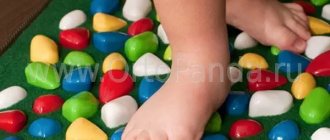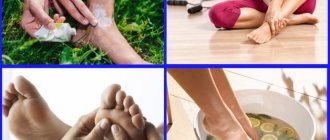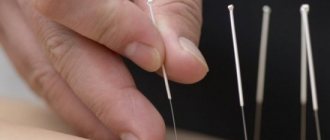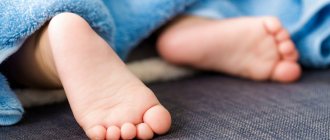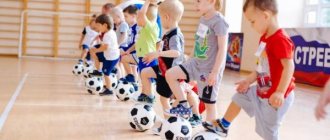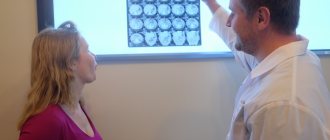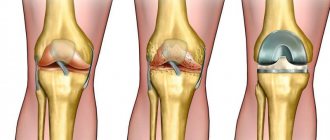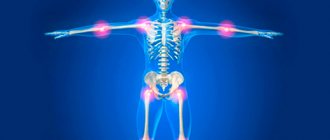Flat feet are one of the most common complaints in the office of a pediatric orthopedist. The term “flatfoot” combines various diseases and anatomical features manifested by smoothing of the longitudinal and transverse arches of the foot.
There are several main classification systems for flat feet based on various characteristics.
Based on severity, there are 3 main degrees. The degree of flatfoot is assessed radiographically. Photographs in the direct and lateral planes are taken with a load.
The degree of transverse flatfoot is assessed by the first intermetatarsal angle and the angle of deviation of the big toe.
In this image, yellow lines form 1 intermetatarsal angle and orange lines form the angle of deviation of the thumb.
Transverse flatfoot by degrees.
| Degree of transverse flatfoot | 1 intermetatarsal angle | Thumb angle |
| 1 | 10-12 ° | 15-20 ° |
| 2 | 15 ° | 30 ° |
| 3 | 20 ° | 40 ° |
| 4 | >20 ° | >40 ° |
The degree of longitudinal flatfoot is assessed by the angle of the longitudinal arch of the foot and the height of the arch.
Don't miss the moment
Fortunately, inherited and acquired foot defects can be corrected. With the help of special rehabilitation measures, it is possible to stop the disease and prevent it from developing into a more severe form. Depending on the child’s age, his development, and the nature of the flattening of the foot, the doctor will prescribe a massage and a special set of exercises that need to be performed at home. If your child does gymnastics diligently, positive results will soon make themselves felt: the arch of the foot will become significantly stronger, take on an arched shape, and the displaced heel will take its usual place.
Daily warm (35–36°C) foot baths, leg and foot massage (rubbing, stroking and kneading) will be good allies. These procedures improve blood circulation and tone the muscles that lift the arch of the foot. Massage the inner surface of the shin in the direction from the ankle to the knee, and the feet from the toes to the heel.
In addition, the specialist will help you choose orthopedic shoes or recommend making individual corrective devices (orthopedic insoles) with arch alignment and raising the inner or outer edge of the heel. The insoles create comfortable conditions for deformed feet; they can be worn from the age of two after consultation with an orthopedic doctor. Do not forget to periodically see a doctor for timely correction of the height of the instep supports. Insoles should be included in both outdoor and indoor shoes.
You should not choose orthopedic shoes on your own: even a small mistake can aggravate the problem.
It is important to remember that all methods of conservative treatment end by the age of 10, when the processes of formation of the physiological arches of the foot are completed and only surgical intervention is possible.
Stores sell many different devices (special mats, cushions, balls) for doing gymnastics and self-massage at home. Exercises help improve blood circulation and normalize muscle tone.
Longitudinal flatfoot by degrees.
| Degree of longitudinal flatfoot | Arch angle | Arch height |
| 1 | 130-140 ° | 35-25mm |
| 2 | 141-155 ° | 24-17mm |
| 3 | 155> ° | 17>mm |
To be fair, it should be noted that this radiological classification is used only in Russia, which is mainly caused by the excitement around issues related to the military registration and enlistment office. In the rest of the world, these angles are taken into account, especially when planning surgical treatment, but do not form a separate classification, since the angles on radiographs and the severity of the clinical picture have little correlation.
Based on the time of occurrence, congenital (associated with developmental anomalies) and acquired forms of flatfoot are distinguished. Congenital causes include such rare and severe forms as congenital vertical talus and calcaneal valgus foot. More common (from 1 to 6% of the population) and less severe causes of congenital flatfoot include calcaneonavicular, calcaneal-talus and some other synostoses, accessory navicular bone. Abnormalities of these bones lead to improper load distribution in the gait cycle and overload of the remaining stabilizers of the foot. The picture of flat feet in this case appears by the age of 8-15, which is associated with ossification and the transition of relatively elastic synchondroses into synostoses.
Depending on which of the arches of the foot is more involved in the pathological process, longitudinal and transverse flat feet are distinguished. Longitudinal flatfoot is more associated with dysfunction of the calcaneonavicular, navicular-cuneiform ligaments, plantar ligaments and plantar fascia. Transverse flatfoot is associated with dysfunction of the adductor pollicis muscle and intermetatarsal ligaments. In most cases, longitudinal and transverse flatfoot are observed simultaneously.
According to the clinical picture, there are 2 main forms of flat feet - rigid and elastic. The elastic form appears only in a standing position, and disappears when rising on the toes or in a resting position. The rigid form remains at rest.
Currently considered a variant of the norm. It is characterized by a decrease in the height of the median longitudinal arch at rest; during loading, a valgus position of the heel bone and abduction in the midfoot are noted.
Extremely widespread (occurs in 20-25% of the population). It has a genetic nature and is observed in families. Often accompanied by hypermobility syndrome in other joints. In most cases, the severity of the deformity decreases with age.
Methods for treating bow legs
Treatment for clubfoot depends on the patient's age and severity of the disease.
As a rule, the congenital variant of the pathology is easiest to correct in early preschool age. It is very important that the effectiveness of therapy depends on the time of initiation - the earlier the disease is detected and treatment started, the greater the likelihood of recovery. For mild forms of pathology, conservative treatment is carried out: ● physical therapy using bandages to fix the feet. All exercises must be carried out under the strict supervision of a specialist; ● temporary application of plaster casts, especially in the case of a congenital form of the disease; ● therapeutic massage to normalize the tone of the foot muscles. Conducted in the form of a course of 10-15 sessions. After its completion, the course can be repeated after a few months; ● wearing special orthopedic shoes that allow you to correct the position of the foot; ● physiotherapeutic procedures - magnetic therapy, the use of therapeutic mud, etc.; ● if clubfoot occurs due to damage to the nervous system, then Proserin may be prescribed. This is a medicine that allows you to restore neuromuscular transmission of impulses. It is important to note that any medications should be prescribed only by your doctor.
In severe cases, surgical interventions are recommended. They allow you to adjust the length of the ligaments and muscles, and with the subsequent wearing of special shoes, these effects are consolidated. Surgeries usually lead to complete restoration of the position of the foot. Thanks to this, children and adults with flat feet and bowed legs can lead an active lifestyle without any discomfort.
Who to contact for flat feet
If you detect any signs of flat feet or club feet in children, you should immediately consult a doctor.
We recommend consulting with a paid pediatrician. He will conduct an initial examination and determine whether an examination by an orthopedic traumatologist is required. How does an appointment with a specialist usually take place? Examination of a child or adult with suspected pathology includes several stages: ● with a congenital variant, parents note an unusual position of the foot and a waddling gait in childhood; ● in adult patients, signs of flat feet are revealed when examining the foot. It is in the wrong position and turned inward; ● to assess the condition of ligaments, tendons and the condition of the arches, ultrasound and other instrumental diagnostic methods are performed. They allow you to confirm the diagnosis and determine treatment tactics.
The Doctor Anna clinic is very popular among adults and children with clubfoot. The doctors of the medical center have extensive positive experience in eliminating diseases of varying severity. The convenient location of the clinic near the metro station makes visiting it accessible at any time of the day. You can make an appointment by phone or by leaving a request on the website.
Diagnosis of hypermobile elastic planovalgus foot.
Most often it does not cause pain symptoms in the child. Pain can be localized in the arch of the foot and along the dorsal surface in the midfoot area.
Upon examination, flat feet appear only in a standing position. Disappears without axial load and when walking on toes. The valgus position of the heel and abduction of the forefoot are determined. There is a full range of motion in the subtalar joint. The valgus position is corrected by standing on the toes. It is necessary to evaluate the length of the Achilles tendon and the amplitude of dorsiflexion of the foot.
X-rays are indicated to rule out other causes of flatfoot, such as vertical talus, accessory navicular, calcaneotalus, and calcaneonavicular synostosis. Radiography is performed with an axial load, and the Meary angle, open to the plantar side, is determined.
SOS signal
The first symptoms of flat feet are that the gait loses its smoothness, the soles of the shoes may slip to one side, and the shoes that recently fit become small due to the expansion of the foot. Children quickly get tired while walking, ask to be held, and complain of pain in the legs or lower back. There are also problems with ingrown toenails.
The onset of the disease can be determined visually by simply looking at the child’s heel to see if it is tilting to one side or the other. In medical language, this is called an X- or O-shaped deformity of the ankle joints. This happens because the weight of the baby’s body when walking is distributed unevenly, and the foot is positioned incorrectly.
Conservative treatment of hypermobile planovalgus foot.
In most cases, this condition is completely asymptomatic. The arch of the foot is restored as the child grows older. If pain occurs, it is recommended to wear orthopedic insoles and orthopedic shoes. If shortening of the Achilles tendon is detected, stretching exercises are recommended.
If conservative measures are ineffective, surgical treatment is indicated. If the main problem is shortening of the Achilles tendon, lengthening plasty is performed. In rare cases of persistent pain, a calcaneal lengthening osteotomy (Evans osteotomy) may be required to correct forefoot abduction. A medializing sliding osteotomy of the calcaneus may be required to correct hindfoot valgus. If there is excessive supination, a plantar wedge osteotomy of the first wedge may be required.
Osteopathy in the diagnosis and treatment of flat feet in children
Flat feet in children most often develop due to a general imbalance in the body. The feet are just a link in the chain of emerging pathologies. They take a forced position, adapting to the body. The task of an osteopath is to identify and correct the root cause of flat feet in a child, while simultaneously eliminating all associated problems. The root cause can be “hidden” in any part of the body, but most often it is located in the skull or in the cervical spine.
To prevent flat feet in children, doctors strongly recommend periodic examinations by a specialist. The effectiveness of flatfoot treatment largely depends on how promptly the parents sought help. Until the age of 7-8, with the help of osteopathy, it is easier to return the feet to the correct position. After 8 years, you can also cure the disease by undergoing treatment for flat feet with an osteopath.
Treatment of flat feet in children should be comprehensive
To consolidate the effect of osteopathic treatment for flat feet, it is necessary to strengthen the muscles and ligaments of the foot with the help of exercises. Our specialists will conduct special gymnastics for training the muscles of the foot and lower leg with the child.
In the meantime, while the arch has not formed, orthopedic insoles will provide significant assistance in the treatment of flat feet, which you can also make directly on the child’s foot in our clinic.
Did you like the article? Add the site to your browser bookmarks
Causes of flat feet
The disease is caused by various factors:
- increased physical stress on the legs;
- excess weight;
- wearing narrow, uncomfortable shoes or high-heeled shoes;
- rickets, polio, diabetes mellitus;
- hereditary predisposition;
- pregnancy.
Older people are more susceptible to flat feet due to aging and decreased muscle strength. The foot is more often deformed in people who spend a lot of time standing at work: salespeople, hairdressers, machine operators, surgeons.

